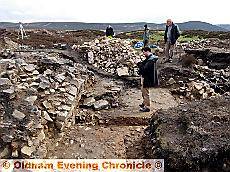Historians unearth 900-year-old castle
Reporter: Geoff Wood
Date published: 13 August 2008

The university team on the site of the medieval castle
WINDSOR, Warwick, Corfe — it is relatively easy to name England’s great castles but soon another may have to be added to the list.
Archaeologists have discovered that in the 12th century one of England’s most important fortified sites stood on the Mossley - Stalybridge border.
The name Buckton Castle is well known to people driving through Carrbrook, if only for the pub they pass, but it was thought to be a Roman emplacement of little significance.
Yet there had been suggestions of something more substantial. A 1359 survey by the Black Prince, son of Edward III who had just acquired the lands, describes it as a ruined castle.
The team from Manchester University’s field archaeology centre has found that the area was home to a stone castle.
They discovered a massive stone outer wall, around 10ft thick, indicating that Buckton was a castle on a scale comparable with Beeston Castle near Chester.
It was possibly built when England was racked by civil war between the forces of King Stephen (1135-1154) and those of the Empress Maud, sometimes called Matilda.
The conflict forms the backdrop to the Cadfael novels by Ellis Peters.
Another theory is that it was built by the second Earl of Chester who may have needed it to protect himself from his sworn enemy, William of Peveril, who went on to poison him in 1153.
But if that were the case,the castle should have faced south, towards Peveril’s lands. rather than north and west.
Alan Rose of the Tameside Local History Forum and Stalybridge Historical Society said: “This is a significant discovery and very exciting.
“Most people thought the name simply referred to the hill and we knew there was some defensive structure there.
“But no one ever thought it was a stone castle in the conventional sense.”
He added that a group researching the diaries of a Saddleworth man had found suggestions that a large amount of stone still remained in the early 19th century.
Further excavations also revealed that the castle was defended by a large rectangular gate tower.
Greater Manchester County Archaeologist Norman Redhead said the scale of the defences clearly indicated a building ‘at the top end of the social hierarchy.
He said: “Greater Manchester is not well known for its castles, but Buckton Castle will put the area well and truly on the castle map as it is clearly the best preserved of the eight known castles in the county area.
“We think it might have been built during the 1140s.
“At the back of the castle lies an old and once important north - south route and the castle may have guarded over this.
“We will be returning next year, funded by Tameside Council, to do further work on site.”
Most Viewed News Stories
- 1A new neighbourhood on the way for Oldham?
- 2Annie-May - most definitely a life well-lived!
- 3Police appeal follows recovery of woman's body from Strinesdale reservoir
- 4‘New’ town hall due to open to public for first time after full cost of major refurb project...
- 5Crompton House students excel again on A Level results day




